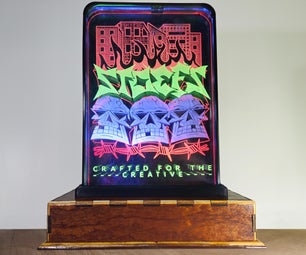Introduction: Ambient LED Shelf Lighting
I found a few great instructables on here, and used a little info from each to create my own ambient shelf lighting. I'm not usually one to get too involved, but since I have taken so much from the site, I felt it was my duty to post my little project. :)
Step 1: Step 1
Okay, I guess here is where I list the parts. Basically all you need are the LEDs, resistors, sewing pins, batteries and some speaker wire. For fancy's sake, I used a project box, switch and battery holder too. To put it all together, you will need wire cutters/strippers (scissors will work in a pinch) and a soldering iron (I suppose you could even just twist them together if you had no tools)
Pic1: I had this little project box that was dug up to practice some wood burning. Decided to use if for this instead.
Pic 2: As you can see in the next picture, i installed a rocker switch on the side, and drilled a hole for the speaker wire to run through,
Pic 3: I plopped the battery holder inside, and ran the wires to the switch, and out the back. (For some reason these cheapo batteries think that 1.5v x 4 = 6.4?? )
Step 2: Step 2
Now for the dangerous part :) Yes, you may bleed.
I figured out which resistor was needed for the two colors (white and blue on 6.4v source). Don't ask me the specs on the resistors, because I punched the stats into an online calculator and used what it spit out.
So I soldered the resistor to the leg of the LED, and then the whole assembly to a sewing pin on either end. The picture describes it better than I could ever explain. :)
I then took my Spiky Light of Death, and pushed each end through either side of the wire. Remember that polarity matters, so make sure the + side of your Spiky Light of Death is pushed through the + side of the wire. Same goes for the - side.
(There is an Instructable here that shows a fella lighting his whole apartment this way. Might explain it a little better than I did, but I cant find the link now :(
Carry on this way, until you get to the length you want. Mine ended up about 3ft long.
Step 3: Step 4
I guess I should have said this in the previous step, but connect your light string to your power source, and your Spiky Lights of Death become Funky Light Art.
Thanks for checking it out. :)



![Tim's Mechanical Spider Leg [LU9685-20CU]](https://content.instructables.com/FFB/5R4I/LVKZ6G6R/FFB5R4ILVKZ6G6R.png?auto=webp&crop=1.2%3A1&frame=1&width=306)





